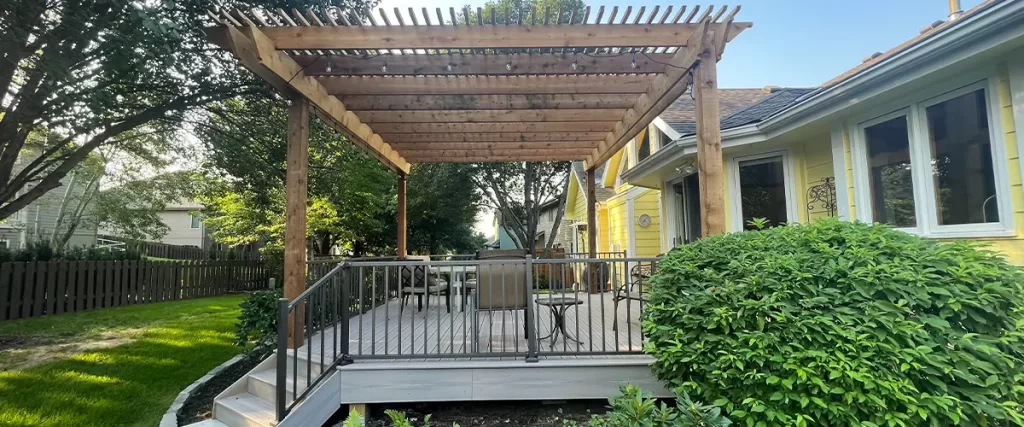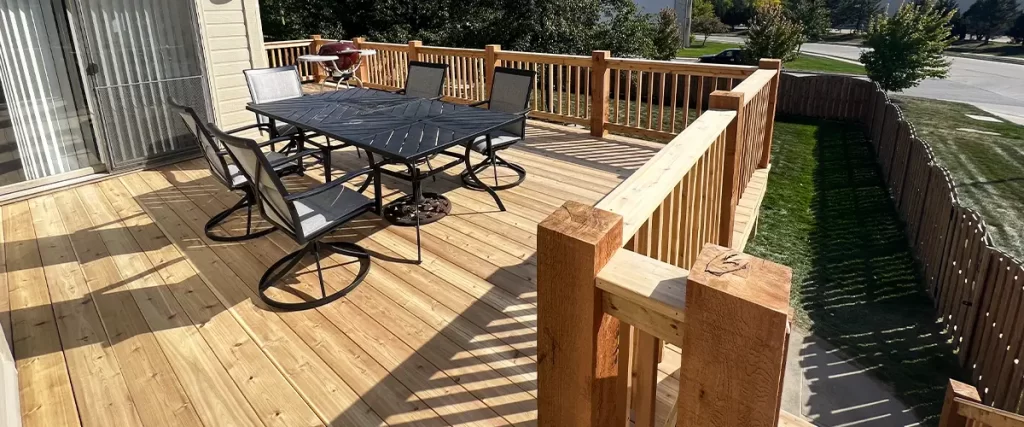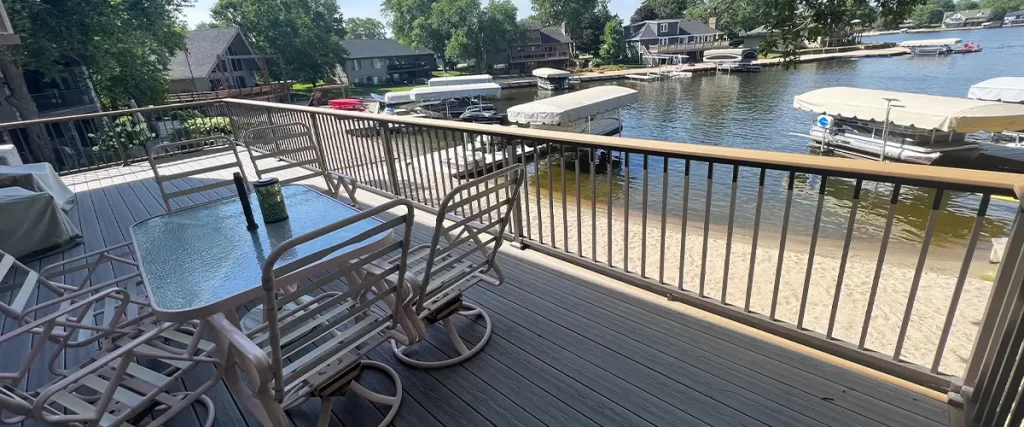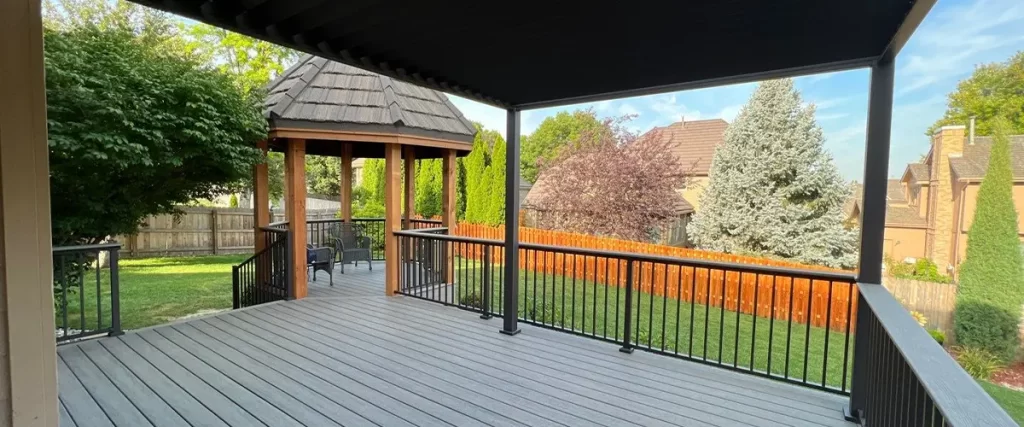If you live in a region that gets hit with high winds, intense storms, or even tornadoes, you probably think about your roof, your siding, maybe your windows. But there’s one part of your home that’s often overlooked when it comes to storm safety: your elevated deck.
When the wind picks up, especially in tornado-prone areas, decks are one of the most vulnerable structures around your home. They’re elevated, exposed, and if not built with wind load in mind, they can be ripped apart or even turned into airborne debris.
Scary? Absolutely. But the good news is, with the right information and preparation, you can design or reinforce your deck to stand strong even in harsh conditions.
Let’s talk about what wind load actually is, how it affects elevated decks, and what you can do to make yours safer and storm-ready.

What Exactly Is Wind Load?
Wind load is the force that wind exerts on a structure. It’s measured in pounds per square foot (psf), and it depends on a few things:
- The wind speed
- The height and shape of the structure
- How much of the structure is exposed
- The direction the wind is coming from
For decks, wind can apply pressure in a few different ways:
- Lateral load: Pushing against the side of the deck.
- Uplift: Pushing upward underneath the deck—particularly dangerous for elevated decks.
- Shear or twisting forces: Especially at the connections and supports.
Think of your deck like a sail in the wind. If it’s not properly anchored and braced, a strong gust can cause real damage—both to the deck and potentially to your home.
Why Elevated Decks Are Especially Vulnerable
Not all decks are created equal when it comes to wind load. Elevated decks—those raised above ground level on posts—are more exposed and structurally complex than low-level platforms or patios.
Here’s why they’re more at risk:
- More surface area exposed to wind
- Less protection from surrounding structures or landscaping
- Taller posts, which are more prone to swaying or collapsing
- Greater uplift potential underneath the deck surface
In tornado-prone areas where straight-line winds and updrafts can reach extreme speeds, this combination makes elevated decks one of the first places you should reinforce.

Real-World Risks in Tornado-Prone Areas
Tornado-prone areas across the U.S.—like the Midwest, Southeast, and parts of the Great Plains—regularly experience wind speeds of 100 to 200+ mph during severe storms. Even lower-rated EF0 or EF1 tornadoes can cause significant damage to decks that aren’t properly constructed.
Risks include:
- Uplift failure: Wind gets underneath the deck and lifts it from the footings.
Lateral failure: Deck collapses or leans due to sideways pressure. - Connection failure: Weak ledger boards or improperly installed fasteners fail, detaching the deck from your house.
- Flying debris hazard: Detached decks can become dangerous projectiles, endangering your family, neighbors, and property.
What Building Codes Say About Wind Load on Decks
Most residential construction in the U.S. follows the International Residential Code (IRC), which provides guidance on wind load resistance, especially for elevated decks.
Some key requirements include:
- Ledger board attachment with lag screws or bolts spaced correctly—no nails allowed.
- Lateral load connectors (like hold-down tension devices) to resist horizontal forces.
- Post and footing specs that account for soil type, deck height, and expected loads.
- Diagonal bracing for tall posts to prevent racking or collapse.
Depending on your wind zone, your deck may need to withstand wind speeds up to:
- 115 mph (Zone I)
- 130 mph (Zone II)
- 150 mph or more (Zone III, tornado alley)
You can find your specific wind zone and code requirements by consulting your local permitting office or reviewing the ASCE 7 Wind Speed Map used in structural design.

How to Make Your Elevated Deck Wind-Resistant
Whether you’re building a new deck or upgrading an existing one, these are the best practices to protect it from wind-related damage.
1. Use Proper Footings and Anchoring
- Concrete footings should extend below the frost line and be properly sized for uplift and lateral loads.
- Use post-to-pier connectors and anchor bolts that are rated for high winds.
- Avoid setting posts directly into soil, which increases the risk of shifting and collapse.
2. Install Lateral Load Connectors
- IRC requires at least two hold-down tension devices (like Simpson DTT2) for decks attached to the house.
- These prevent the deck from pulling away in high winds.
3. Add Diagonal Bracing
- Diagonal braces between posts and beams provide crucial stability against lateral wind loads.
- For elevated decks, bracing in both directions (parallel and perpendicular to the house) is key.
4. Reinforce the Ledger Board
- This connection is often the weakest point of a deck. Make sure it’s flashed correctly and fastened with bolts or structural screws—not nails.
- Use blocking or backing inside the wall to prevent pull-out.
5. Minimize Uplift Risk
- Add hurricane ties or tension ties between joists and beams.
- Close off the area beneath your deck with skirting or wind-permeable panels to reduce wind pressure under the surface.
Materials Matter: Wood vs. Composite vs. Steel
Different materials react differently to wind and stress.
- Pressure-treated wood is strong but can degrade over time, especially at connection points.
- Composite decking holds up well but relies heavily on the strength of the substructure.
- Steel framing systems are increasingly used in high-risk zones because of their superior strength and resistance to warping or rotting.
Regardless of your material choice, connections and fastening are far more critical than the decking surface itself when it comes to wind resistance.
Red Flags: Signs Your Deck May Not Be Wind-Ready
Take a few minutes to inspect your deck. If you spot any of the following, it’s worth taking action before storm season ramps up:
- Wobbly or swaying posts
- Gaps between the house and deck ledger board
- Loose or rusted bolts, screws, or connectors
- No visible bracing underneath an elevated deck
Deck boards pulling away or bouncing when stepped on
Frequently Asked Questions
Can a tornado really lift a deck off the ground?
Yes, especially if the deck isn’t anchored correctly. High winds can create enough uplift pressure to separate the deck from its footings or structure.
What’s the best way to anchor a deck for wind resistance?
Use concrete footings, metal post bases, and mechanical connectors rated for uplift and lateral forces. Add lateral load connectors between the deck and house.
Are composite decks safer than wood in wind-prone areas?
Not necessarily. Wind resistance depends more on the framing and connections than the deck surface. Composite materials are durable, but you still need proper bracing and fasteners.
Is there a maximum height for elevated decks in high-wind zones?
There’s no universal max height, but the taller the deck, the more bracing and engineering are required. Always check with local building codes and possibly consult a structural engineer for tall designs.

Final Thoughts: Build With the Wind in Mind
Wind load isn’t just a theoretical engineering term; it’s a real force that can destroy your deck if you’re not prepared. Elevated decks are beautiful, functional, and often the highlight of a home’s outdoor space, but they come with structural responsibilities, especially in tornado-prone areas.
The solution? Build smart. Anchor everything. Brace what needs bracing. And stay up to code.
If you’re unsure about your deck’s wind readiness or thinking about building a new one, don’t leave it to chance.
Contact us at (402) 369-5724 to get your deck building project started!
